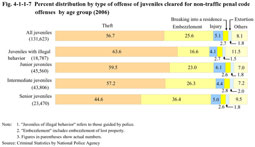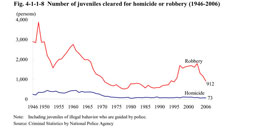| Previous Next Index Image Index Year Selection | |
|
|
3 Trends by type of offense
(1) Percent distribution by type of offense
Fig. 4-1-1-7 shows the percent distribution by type of offense of juveniles cleared for non-traffic penal code offenses (including juveniles of illegal behavior who are guided by police) in 2006, by age group. The older an age group was, the lower the percent ratio for theft was (see Appendix 4-3). Fig. 4-1-1-7 Percent distribution by type of offense of juveniles cleared for non-traffic penal code offenses by age group (2006) (2) Homicide and robberyFig. 4-1-1-8 shows the number of juveniles cleared for homicide or robbery (including juveniles of illegal behavior who are guided by police) since 1946. Fig. 4-1-1-8 Number of juveniles cleared for homicide or robbery (1946-2006) Those cleared for homicide showed increases and decreases between 200 and 500 up until the late 1960s, but have been on a declining trend since then, remaining below 100 since 1975. From 1998 to 2001, the number exceeded 100, but has been below 100 again since 2002.Those cleared for robbery showed an upward trend since 1989, reaching a peak at 1,800 in 2003. However, the number decreased for three consecutive years from 2004. Most robbery cases were on-the-street robbery (Source: The Community Safety Bureau, National Police Agency). |

